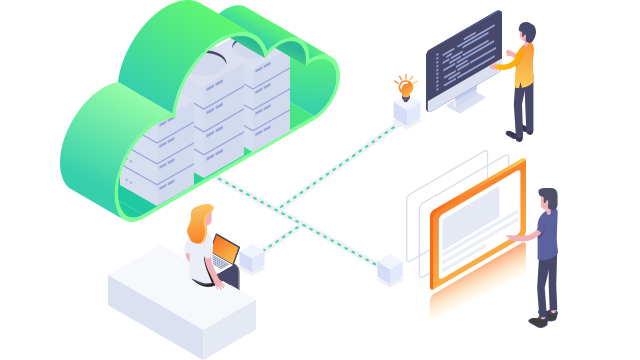AI Cloud Instance
Our cloud service makes it easy to deploy container-based GPU instances in seconds, from either public or private repositories. This means that you can get started with GPU computing quickly and easily, without having to worry about managing your own hardware.

Облачный майнинг
Откройте для себя майнинг в любое время и в любом месте! Мы возьмем на себя все сложности, чтобы вы могли просто наслаждаться вознаграждениями. Начните майнинг в несколько кликов!
Minerplus
Проблемы с центром данных? Мы поможем вам использовать универсальную систему управления.

Ресурсы
Ознакомьтесь с нашим центром ресурсов, чтобы найти необходимую информацию. Подпишитесь и будьте в курсе последних новостей, объявлений и публикаций в блоге.
Подпишитесь на нашу рассылку
Блог о майнинге биткоина и криптовалютах . 09.03.2024
What Is Machine Learning? Understanding Its Mechanisms and Impact
Unlock the secrets of Machine Learning with our comprehensive guide. Dive into what Machine Learning is, how it works, and its transformative impact across industries.

In an era where technology relentlessly evolves, one groundbreaking concept has continuously transformed the digital landscape: Machine Learning (ML). Unlock the secrets of Machine Learning with our comprehensive guide. Dive into what Machine Learning is, how it works, and its transformative impact across industries.
What is Machine Learning?
Creating algorithms with the ability to learn from data and then use that knowledge to generate predictions or judgments is at the heart of machine learning, a branch of AI. Algorithms like this are developed to do things that humans just can't do, including sifting through enormous databases for hidden patterns and insights.
How Does Machine Learning Work?
A primary goal of machine learning is to provide computers the ability to learn and grow in response to new data and situations without human intervention. Machine learning algorithms construct models from data samples rather than relying on pre-programmed rules to arrive at conclusions or forecasts.
It would be very challenging, if not impossible, for humans to manually discover the patterns and correlations that machine learning is capable of discovering. Image identification, recommendation systems, predictive analytics, and natural language processing are just a few of the many applications that benefit from this.
What are the Different Types of Machine Learning?
Many different approaches exist in the field of machine learning, each with its own special features and practical uses. We can learn the primary types below :
Supervised Learning
Supervised learning involves training the algorithm with inputs and outputs already defined in a labeled dataset. The objective is to figure out how to take in data and use it to generate labels and values as output. With this training in hand, the algorithm is able to generate predictions and, with each iteration, gets better at making accurate predictions.
*Representative algorithm: Linear regression, logistic regression, decision trees, random forests, support vector machines, neural networks.
Unsupervised Learning
It can't use labeled data with unsupervised learning, unlike supervised learning. For tasks like clustering or association, this is where the algorithm makes an autonomous effort to find patterns and correlations in the data.
*Representative algorithm: K-means clustering, hierarchical clustering, principal component analysis (PCA), association rules.
Semi-Supervised Learning
One method that combines supervised and unsupervised learning is semi-supervised learning. When acquiring a completely tagged dataset is too costly or impractical, this approach comes in handy.
*Representative algorithm: Self-Training, Co-Training, Generative Models, Graph-Based Methods, Low-Density Separation
Reinforcement Learning
The algorithm in reinforcement learning learns by doing, with the help of incentives and penalties. Games, navigation, and making decisions in real-time all make use of this type.
*Representative algorithm: Q-learning, policy gradients, deep reinforcement learning.
Deep Learning
Neural networks having numerous layers are used in deep learning, a branch of machine learning. Complex tasks such as picture and speech recognition are greatly improved by the ability of these layers to learn more abstract representations of the data.
*Representative algorithm: Artificial Neural Networks (ANNs), Convolutional Neural Networks (CNNs), Recurrent Neural Networks (RNNs), Autoencoders.
How to Choose and Build the Right Machine Learning Model
There is a specific procedure to follow when selecting and developing a machine learning model. Get a good grasp of the issue at hand, your end goal, and the nature of the data. Clean up the data, design some features, and divide it into training, validation, and test sets as part of the preprocessing. Problem nature, data characteristics, and needs (such as speed or interpretability) should be considered while choosing an algorithm. Apply the appropriate metrics to the validation set and train the model on the training data. Tune hyperparameters, use regularization methods, and avoid overfitting with cross-validation to achieve optimal performance. It's crucial to try using various algorithms or ensemble approaches for improving performance.
After you're satisfied with the model, put it into production and keep an eye on how it does in the real world. If needed, make adjustments. Take careful notes on all choices, trials, and outcomes. Think about real-world limitations like computing power, scalability, and deployment needs before you choose a model. Building an effective, well-suited machine learning solution requires an iterative strategy that combines domain expertise with systematic evaluation.
Advantages and Disadvantages of Machine Learning
The benefits and drawbacks of machine learning are listed in the table below:
| Pros | Cons |
| Efficiency at Scale - Automates repetitive tasks | Data Dependency - Bias in data results in inaccuracies |
| Pattern Discovery - Identifying correlations in data | Complexity and Interpretability - Lead to a 'black box' |
| Personalization - Powers customers in various domains | Resource Intensive - Expensive and time-consuming |
* "Black Box" model refers to models whose internal working mechanisms are opaque and difficult to understand. These models can produce predictions or decisions, but their decision-making processes are difficult to trace, making it challenging for external observers to explain the specific behaviors and reasons behind the model's outputs.
Machine Learning Examples in Industry
Machine learning is having a profound impact on numerous industries. Improving healthcare through better patient diagnostics, analytics for prediction, and tailored treatment programs. In the financial sector, it is utilized to detect fraud, automated trading, and risk evaluation. For marketing, ML powers customized ads, consumer segmentation, and analysis of predicted consumer behavior.
The Future of Machine Learning
Further developments in deep learning, unsupervised methods, multimodal models, and breakthroughs in reinforcement learning bode well for the future of machine learning. Improved artificial intelligence will be made possible by the widespread use of multimodal learning models. These models may integrate the processing and learning of several modalities, such as text, images, audio, etc.
Machine learning is set to revolutionize various fields and propel innovation in all kinds of companies. Although there are obstacles, the sector is making great strides that will allow for revolutionary technical developments in the future and address complicated difficulties.
Bitdeer and AI
In addition to sharing AI basic information, Bitdeer's mission is to build an environment in which artificial intelligence (AI) is approachable, comprehensible, and useful. To learn more about Cloud GPU, Click here.
DISCLAIMER
*Information provided in this article is for general information and reference only and does not constitute nor is intended to be construed as any advertisement, professional advice, offer, solicitation, or recommendation to deal in any product. No guarantee, representation, warranty or undertaking, express or implied, is made as to the fairness, accuracy, timeliness, completeness or correctness of any information, or the future returns, performance or outcome of any product. Bitdeer expressly excludes any and all liability (to the extent permitted by applicable law) in respect of the information provided in this article, and in no event shall Bitdeer be liable to any person for any losses incurred or damages suffered as a result of any reliance on any information in this article.








